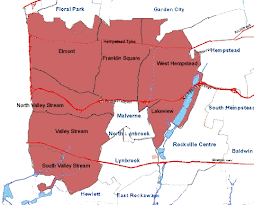The Nassau County Police Department would like to remind residents that as the temperature rises, it's important to KEEP YOUR COOL. Know the warning signs, and treatment, of common heat-related problems.
HEAT STROKE ("sunstroke") occurs when the body can't rid itself of excess heat, and there is a sudden rise in body temperature. Symptoms appear rapidly: look for very hot and dry skin (no sweat),dizziness, nausea, confusion and unconsciousness. Lower the body temperature as quickly as possible.
Move the person to a cool area, or immerse in/pour cool water over the person. SEEK
MEDICAL ATTENTION IMMEDIATELY: HEAT STROKE CAN BE FATAL.
HEAT EXHAUSTION is a mild form of shock from excess exposure to heat. Look for
pale, clammy skin with profuse sweating, headache, dizziness, fatigue, and sometimes
abdominal cramping. Body temperature remains close to normal. Move the person to a
cool area.
HEAT SYNCOPE (loss of consciousness) is due to decreased blood flow to the brain
and heart as the blood pools in the extremities. The person will quickly regain consciousness when lying down. Allow the victim to rest, and remove from the activity or
environment which caused the loss of consciousness.
HEAT RASH ("prickly heat") is caused by blocked sweat ducts. Although not dangerous,
the rash has a tingly or prickly feeling. Shower or wash often, dry your skin
completely and change into dry clothing. Stay out of the heat until the rash is gone.
HEAT CRAMPS (mild to severe muscle cramps in the arms, legs or abdomen) are
due to profuse perspiration. Look for pale, moist skin with heavy sweating and
occasional nausea or faintness. Move the person to a cool area but do not massage
the cramped muscles. If not nauseous, slowly sip one or two glasses of an electrolyte
drink. Do not resume the activity which caused the cramps for at least 12 hours or the cramps may return.
THE POLICE DEPARTMENT OFFERS THE FOLLOWING
10 SUGGESTIONS TO PREVENT HEAT RELATED ILLNESSES:
1. The elderly and young children under five years of age, especially
babies under one year, are particularly sensitive to heat's effects. Be sure to
offer plenty of liquids to drink, keep them in the shade, and take care not to
overdress them.
2. GET OUT OF THE HEAT
Take advantage of air conditioned facilities such as indoor shopping malls,
public libraries, movie theaters, municipal buildings, or senior citizen centers. If
you must go outside try to limit these excursions to early morning or later in the
evening when temperatures are lower.
3. STAY IN THE SHADE
When you are outdoors stay out of direct sun when possible. There can be a
ten to fifteen degree difference in the temperature when you are in the shade.
4. USE FANS, EVEN IF YOU HAVE AIR CONDITIONING
While electric fans do not cool, a fan in each room will help to circulate air and
lower temperatures. If you don’t have air conditioning ... create cross-ventilation
by opening windows on two sides of the building, keep curtains, shades or
blinds drawn during the hottest part of the day, and open windows at night. Try
to spend a few hours in an air conditioned building.
5. COOL YOUR BODY TEMPERATURE
If possible, take a cool bath or shower. Cool water will help you to dissipate
body heat.
6. WEAR LOOSE FITTING CLOTHING IN LIGHTER COLORS
Dark colors will absorb heat. Loosely woven cotton and linen (natural fibers) are
much cooler than knits and synthetic fabrics.
7. DRINK PLENTY OF FLUIDS
Try to drink 8 - 10, 8 ounce cups of liquid daily. Carry water or juice with you
and sip continuously even if you do not feel thirsty. Snack on vegetables and
fruit since they have a high water content.
8. AVOID ALCOHOL AND CAFFEINE
Stay away from caffeinated beverages and alcohol, which can dehydrate the
body. Alcohol may also dull your perception of the actual temperature.
9. SALT AND ELECTROLYTES
Don’t take salt tablets unless you check with your doctor first. You get enough
salt from your food or drinking a sports drink.
10. PETS can be affected by the heat. Keep their water dish full, and keep them
indoors or in the shade during peak hours. Never leave an animal in a locked
car, even for a few minutes.
P.O. Jesse Atchison
Wednesday, July 7, 2010
Subscribe to:
Post Comments (Atom)


No comments:
Post a Comment